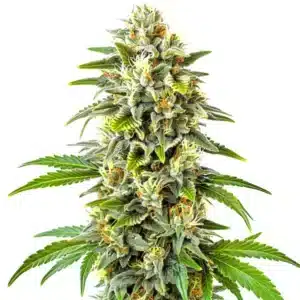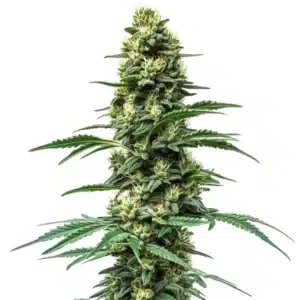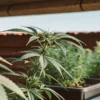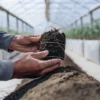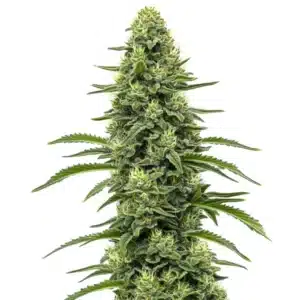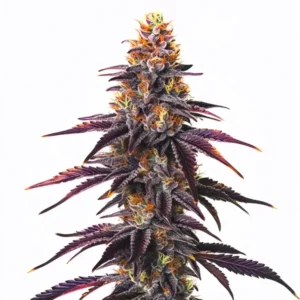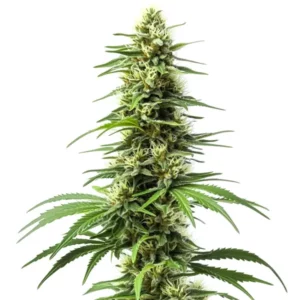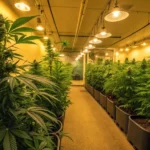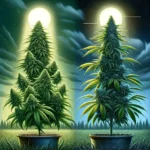
Cannabis Cultivation: Light Spectrum Strategies
Cannabis cultivation is an art and science, and light plays a crucial role in the process. Different light spectrums can influence the growth and yield of your cannabis plants. Learning how to manipulate light can be your secret to bountiful harvests.
When it comes to light spectrum strategies, it’s essential to consider the various stages of cannabis growth. Each stage requires different light conditions to optimize plant health and yield. For example, the vegetative stage thrives under a light spectrum rich in blue light, while the flowering stage benefits from more red light.
Recommended Strains
Blackberry Moonrocks
|
|
THC | 26% - 33% (High) |
|
|
Type | Feminized |
|
|
Yield | High |
|
|
Phenotype | 80% Indica / 20% Sativa |
GG4
|
|
THC | 27% (High) |
|
|
Type | Feminized |
|
|
Yield | High |
|
|
Phenotype | 40% Indica / 60% Sativa |
One strain that responds well to tailored light strategies is the GG4 from Blimburn Seeds. This strain, known for its robust growth, benefits significantly from a carefully managed light spectrum, particularly during its flowering phase.
Optimal Light Spectrum for Cannabis Growth
Choosing the right light spectrum for your cannabis plants is vital. The light spectrum refers to the range of light wavelengths emitted by a light source. In cannabis cultivation, different wavelengths promote different types of growth.
Blue light, which has a shorter wavelength, is ideal for the vegetative stage. It encourages healthy and robust leaf growth. On the other hand, red light, which has a longer wavelength, is crucial during the flowering stage. It supports the development of buds and enhances yield quality.
Knowing the optimal light spectrum for cannabis growth can significantly influence the success of your cultivation efforts. By tailoring the light spectrum to the specific needs of your plants at each growth stage, you can enhance photosynthesis and promote vigorous growth.
Moreover, growers have found that incorporating UV and far-red light into their lighting strategy can further optimize plant growth. These additional wavelengths can improve cannabinoid production and overall plant resilience, making your cannabis cultivation efforts even more fruitful.
Indoor Cannabis Cultivation Light Strategies
Growing cannabis indoors allows for greater control over the light spectrum your plants receive. This control is essential for maximizing plant potential. By using artificial lights, you can provide the exact spectrum needed at each growth stage.
One popular choice for indoor growers is LED lighting. LEDs can be adjusted to emit specific wavelengths, making them perfect for targeting the needs of your plants during both vegetative and flowering stages. They are energy-efficient and produce less heat, reducing the risk of burning your plants.
Indoor cannabis cultivation light strategies often involve a combination of light sources to simulate the natural changes in sunlight. This approach can help in mimicking seasonal variations and optimize plant responses to light changes.
Advanced growers often employ smart lighting systems that allow for automated adjustments to the light spectrum throughout the day. This technology ensures that your cannabis plants receive the most beneficial light conditions at all times, leading to healthier growth and higher yields.
LED vs HPS Lights for Cannabis
LED and HPS lights each have their pros and cons. Choosing between them depends on your cultivation goals and resources. LEDs, with their customizable spectrum and efficiency, are great for small to medium-sized operations.
HPS lights, although more energy-consuming, are preferred by some for their superior performance in the flowering stage. They produce a light spectrum rich in red wavelengths, which is ideal for bud development.
The debate of LED vs HPS lights for cannabis often centers on energy consumption and light intensity. LEDs offer a sustainable option with their lower energy demands, while HPS lights are valued for their intense output, which some growers believe enhances bud density.
Ultimately, the choice between LED and HPS lights will depend on factors such as budget, grow space, and specific strain needs. Many growers find that a hybrid approach, using both types of lights, can offer the best of both worlds in achieving optimal results in cannabis cultivation.
Promos & Deals
Cannabis Light Spectrum for Flowering Stage
The flowering stage is where your cannabis plants start to show their true potential. Light spectrum adjustments are crucial during this period to maximize yield and potency. Red and far-red wavelengths are particularly important as they promote flowering and fruiting.
Balancing these wavelengths can lead to healthier plants and more abundant harvests. Some growers incorporate a mix of both LED and HPS lights to take advantage of the benefits each offers during this stage.
Knowing the importance of the cannabis light spectrum for the flowering stage can transform the quality of your harvest. By focusing on red and far-red wavelengths, you can enhance bud development and increase cannabinoid concentration.
Furthermore, some innovative growers are exploring the use of supplemental lighting that includes UV and infrared wavelengths during the flowering stage. These additional light spectrums can stimulate the production of secondary metabolites, which contribute to the plant’s aroma and potency.
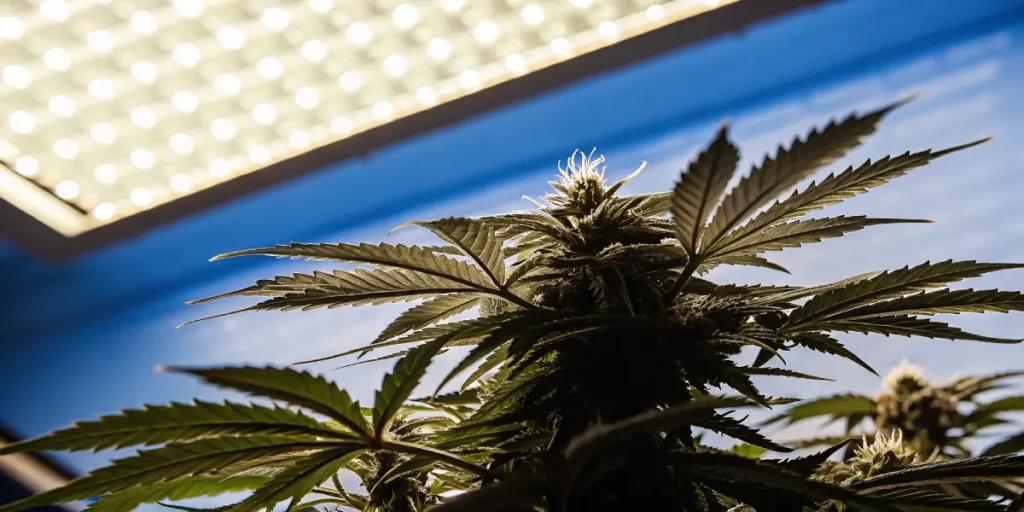
Best Light Wavelength for Cannabis Yield
The best light wavelength for cannabis yield often involves a combination of red and blue light. While red light is crucial for flowering, a hint of blue light can help maintain plant structure and prevent excessive stretching.
Certain strains, such as Blackberry Moonrocks from Blimburn Seeds, are known to produce impressive yields when exposed to a balanced light spectrum that includes both red and blue wavelengths.
Experimenting with the best light wavelength for cannabis yield can lead to significant improvements in both quantity and quality of your harvest. By carefully adjusting the light spectrum, growers can optimize photosynthetic efficiency and encourage denser bud formation.
Incorporating a dynamic lighting strategy that adapts to the plant’s growth cycle can further enhance yield. By gradually shifting the light spectrum as the plants transition from vegetative to flowering stages, growers can ensure optimal conditions for each phase of development.
FAQs
What is the optimal light spectrum for cannabis growth?
The optimal light spectrum for cannabis growth varies between the vegetative and flowering stages. During the vegetative stage, a light spectrum rich in blue wavelengths fosters healthy leaf development. In contrast, the flowering stage benefits from a spectrum with more red wavelengths, crucial for bud development and yield.
Knowing the light needs of your plants at different growth stages is key. Tailoring the light spectrum to these needs can enhance plant health and maximize yield. Strains like Gorilla G4 from blimburnseeds.com are known to respond well to these tailored light strategies.
For growers aiming to achieve the optimal light spectrum for cannabis growth, integrating advanced lighting technologies can be beneficial. Systems that allow precise control over light intensity and spectrum can replicate ideal sunlight conditions, enhancing growth and yield.
Additionally, continuous monitoring and adjustments based on plant responses can further refine your light spectrum strategy. This proactive approach ensures that plants receive the most beneficial lighting throughout their growth cycle, leading to more consistent and bountiful harvests.
How do indoor cannabis cultivation light strategies differ from outdoor growing?
Indoor cannabis cultivation allows for precise control over light conditions, unlike outdoor growing where light is dependent on natural sunlight. Indoors, growers can manipulate the light spectrum to cater to the specific needs of their plants at various growth stages.
This control is particularly advantageous for strains such as Amnesia Haze from blimburnseeds.com, which benefits from the ability to adjust light wavelengths to optimize growth and flowering. This flexibility is one of the main advantages of indoor growing.
Indoor cannabis cultivation light strategies offer a unique advantage in terms of consistency and predictability. By controlling environmental factors such as light, temperature, and humidity, growers can create an optimal growing environment year-round.
Moreover, indoor setups often allow for experimentation with new light technologies and strategies, such as the use of full-spectrum LEDs or light movers. These innovations can further enhance the growth potential and yield of cannabis plants, making indoor cultivation a preferred method for many professional growers.
What are the benefits of using LED lights over HPS lights for cannabis?
LED lights offer several advantages over HPS lights, including energy efficiency, lower heat output, and the ability to adjust the light spectrum precisely. These features make LEDs a popular choice for many indoor cannabis growers.
However, HPS lights are still favored by some for their intense light output, which is particularly beneficial during the flowering stage. The choice between LED and HPS often depends on specific cultivation goals and resources.
One of the major benefits of using LED lights over HPS lights for cannabis is the cost savings in energy consumption. LEDs typically require less electricity, reducing operational costs while still providing high-quality light for plant growth.
Additionally, the ability to fine-tune the light spectrum with LEDs offers a level of control that is unmatched by HPS lights. This precision allows growers to adapt the lighting to the specific requirements of different cannabis strains, optimizing growth and maximizing yield potential.
Why is the cannabis light spectrum for flowering stage so important?
The cannabis light spectrum during the flowering stage is crucial because it directly impacts bud development and yield. Red and far-red wavelengths play a significant role in promoting flowering and enhancing the quality of the buds.
Adjusting the light spectrum to favor these wavelengths can lead to more robust flowering, higher potency, and improved yield. Strains like Blackberry Moonrocks from blimburnseeds.com thrive with a well-balanced spectrum during this vital stage.
The importance of the cannabis light spectrum for the flowering stage cannot be overstated, as it determines the final quality of the harvest. By providing the right balance of red and far-red light, growers can stimulate rapid bud growth and enhance resin production.
Moreover, the flowering stage is when cannabis plants develop their unique terpene profiles, influenced by the light spectrum. A well-managed light strategy during this phase can result in more aromatic and potent buds, greatly affecting the overall quality and marketability of the final product.
Can adjusting light spectrum improve cannabis yield?
Yes, adjusting the light spectrum can significantly improve cannabis yield. By providing the right wavelengths at the appropriate growth stages, you can enhance plant growth, structure, and potency.
Experimenting with different light settings to find the optimal conditions for your strains can lead to better quality buds and higher yields. Tailoring light spectrum strategies to specific strains like those from blimburnseeds.com can yield impressive results.
Adjusting the light spectrum is a powerful tool in maximizing the potential of cannabis crops. By carefully calibrating the light spectrum, growers can influence the plant’s hormonal responses, leading to increased flower density and improved cannabinoid profiles.
Furthermore, ongoing research and experimentation with different light spectra can provide new insights into optimal growing conditions. This continuous adaptation and refinement of light strategies are key to staying competitive in the evolving field of cannabis cultivation.





